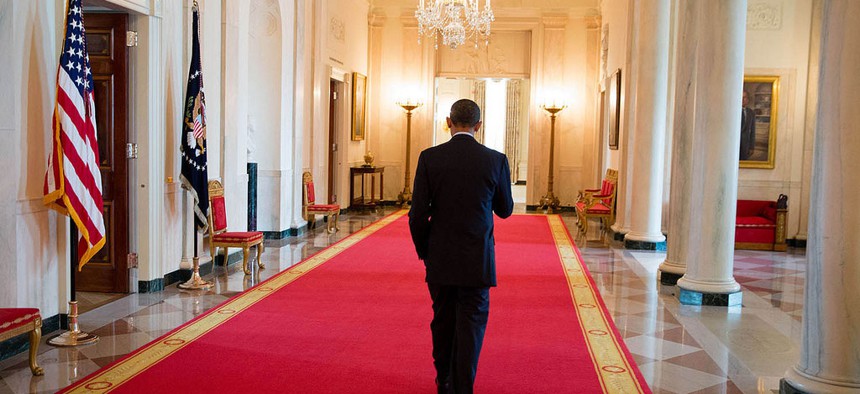
White House Photo by Pete Souza
For Obama, Few Options in Syria
President Obama said there is no military solution for Syria, but sources say counterterrorism ops and direct arms are back on the menu of lousy options. By Gayle Tzemach Lemmon
Once again, with some renewed urgency, White House officials have asked the administration’s Syria policy team to return to the menu of limited and lousy options available in Syria. Syria’s war has grown bloodier since the United States chose not to launch military strikes last summer in favor of a deal to get chemical weapons out of the hands of President Bashar al-Assad. The second round of Geneva talks on the country’s future have produced little aside from a commitment to convene and a growing sense that the sides aren’t yet ready for the negotiating table. Meanwhile, the bloodletting continues and the regime continues to drop barrel bombs onto Syrian civilians.
There is great frustration in Washington at the slow pace of talks and the acceleration of the killing. Ideas under consideration, according to senior administration officials and those familiar with Syria policy, include counterterrorism operations inside Syria, stepping up efforts to arm moderate rebels and humanitarian airdrops of food and other supplies to assist Syrians trapped in the war’s crossfire. But few expect the military options to appear any easier or be much better received than they were the last time. As the administration has said for months, and as President Barack Obama said last week, “there is no military solution” in Syria.
Congress’s deep skepticism has also put a chill on the resurging talk of potential military intervention. Lawmakers refused the administration the authority for intervention last summer, and Congress seems no more interested in the use of limited, if sustained, military force than it was in August.
It is not just the ghost of Iraq that is hanging over American policy in Syria, it is also the experience in Bosnia, according to conversations over the past eight months with U.S. officials. How do you get out of a war once you get in? And does America really have the stamina to enter into another country’s civil war?
Questions over who to support in Syria, and how, have hovered over the discussion for months now. For well over a year the Obama administration faced pressure from within its own ranks to intervene militarily, at least by supporting the moderate rebels battling Assad. Led by the State Department, those who favored funding and even arming the rebels said it was the only way for the U.S. to counter the rising strength of al-Qaeda linked fighters and extremists flooding Syria. While the administration agreed to provide small arms to the rebel fighters -- and battled to win congressional approval for the move -- those close to rebel forces say it has not had a significant impact in shaping events on the ground. Extremist forces remain better funded and better armed.
Even non-lethal aid has proven complicated and is now delayed by rebel leadership infighting and congressional constraints. Late last year, the Obama administration stopped delivering some food and medial supplies after extremist fighters raided and plundered Free Syrian Army warehouses close to the Turkish border. That upheaval was part of what eventually cost Gen. Salim Idris his job as commander of the Free Syrian Army’s Supreme Military Council. His replacement, former Syrian army commander Brig. Gen. Abdul-Ilah al-Bashir, who left for the opposition in 2012, was announced last week, but Idris continues to say that he is in charge.
Now the non-lethal aid is said to be in warehouses and ready to go, but with Idris gone and the SMC in turmoil, it is unclear when that aid will resume. New supplies need new congressional approval before they can be distributed. Sources familiar with the aid discussion say the toppling of the SMC’s command and control structure means that those trying to get the supplies to the rebel fighters once more have to convince members of Congress about where and to whom, exactly, the supplies are going. Among the options being considered is offering the aid directly to units themselves. Another is getting the supplies to the Syria Revolutionaries’ Front, a newly formed rebel alliance said to be supported by Saudi Arabia and other Gulf powers.
What is certain is that the money for the supplies has been approved. What is less clear is how the supplies will get in. Since the start of the conflict nearly three years ago the Obama administration has pivoted between calling for Assad’s ouster and working with him as a partner, including agreeing on a chemical weapons deal. No matter what options the U.S. may consider, few officials close to Syria policy see an end to the civil war in sight. The Syrian regime’s position has only grown stronger since last summer and today the U.S. and Europe deem the most pressing threat in Syria as coming from extremist rebel fighters now battling the regime.
U.S., European and Canadian officials are working to get the best intelligence on who is fighting in Syria, how long they are staying and from where they are traveling. In the last several months the rising number of foreign fighters has entered the country most often through NATO ally Turkey. The surging concern is that those fighters will take what they learned battling the Assad government and use it to launch attacks against targets in the West. Director of National Intelligence James Clapper, who has called Syria an “apocalyptic disaster,” noted that some extremist fighters in Syria “harbor designs on attacks ... in Europe and the homeland.”
Syria’s war may be viewed as a growing threat to U.S. security interests, but despite the renewed deliberations one thing has not changed since last summer: the lack of appetite for a military answer to the conflict. The Obama administration senses there is little support among the American public to intervene in Syria and regardless of the frustration over civilian casualties, the ghosts of conflicts past make it hard to envision America pursuing a military course toward ending the bloodshed.





